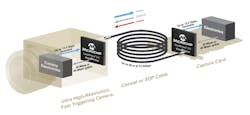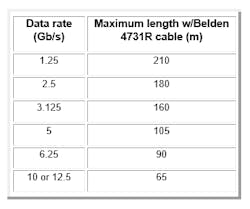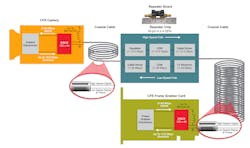Revealing Potentially Overlooked Advantages of CoaXPress 2.0
Zeph Freeman
CoaXPress 2.0 introduced several new capabilities, but some features beyond just higher speeds may be less known to the general machine vision audience. The following article looks at advantages of CoaXPress 2.0 and how they can benefit machine vision systems today and in the future.
Created by Adimec (Eindhoven, The Netherlands; www.adimec.com), Active Silicon (Iver, Buckinghamshire, UK; www.activesilicon.com), Microchip/EqcoLogic (Chandler, AZ, USA; www.microchip.com), AvalData (Tokyo, Japan; www.aval-global.com), and Components Express (Woodridge, IL, USA; www.componentsexpress.com), CoaXPress is an open standard hosted globally by the Japan Industrial Imaging Association (JIIA) and supported by the AIA and EMVA. Primary applications include those requiring high speeds, low latency, long cables, and low power consumption in areas such as industrial inspection, medical imaging, traffic monitoring, and video surveillance.
CoaXPress uses standard 75-ohm coaxial cable as the transmission medium with BNC, micro BNC, or HD-BNC connectors and represents the only standard that allows video, camera control, and triggering over a single coaxial cable, along with 13 W of DC power at 24 VDC. A CoaXPress 2.0 system (Figure 1) includes a camera that incorporates a Microchip Technology transceiver System on Chip (SoC) with an integrated high-speed equalizer, re-clocker, and cable driver in a small package. It consumes about 125 mW at its full 12.5 Gb/s speeds and less power at slower speeds. At the other end of the link, a frame grabber that typically uses the same SoC includes an FPGA for image processing sends power along with control and triggering signals to the camera.
CoaXPress 1.0 supports a 6.25 Gb/s maximum data rate, or about six times faster than GigE Vision and 40% faster than USB3 Vision. Data rates separate into tiers, from CXP-1 (1.25 Gb/s up to 210m) to CXP-6 (6.25 Gb/s up to 90m). CoaXPress 1.0 remained much the same until the 2019 introduction of CoaXPress 2.0, which adds two tiers: CXP-10 (10 Gbps) and CXP-12 (12.5 Gbps), both with a range greater than 65m (based on the use of Belden 4731R cable) and even greater distances using repeaters (Table 1).
A four-link CoaXPress 2.0 frame grabber transfers data at 50 Gbps compared to GigE Vision’s 10 Gbps. Higher data rates of more than 100 Gbps can be achieved with an eight-channel frame grabber card or two 4-channel frame grabber cards. This performance exceeds nearly all requirements today but may be required in the future. In addition, repeaters can be used with CoaXPress 2.0, making it possible to reach several hundred meters (Figure 2).
Doubling the maximum data rate in CoaXPress 2.0 also reduces by half the number of cables required to achieve a given data rate. Upgrading from tier to tier can be done without replacing all the cable infrastructure. Coaxial cable is inherently shielded by its outer conductor, making it highly resistant to external sources of electromagnetic interference (EMI) present in many operating environments, especially electrically noisy factory environments. This allows CoaXPress to be used in applications such as medical imaging, in which the imaging system is deliberately located away from the processing system for both safety and EMI perspectives.
Related: How FPGAs are used in embedded vision applications
CoaXPress also supports GenICam, the industry-standard application programming interface that simplifies application development or upgrading components, as well as the new Generic Data Container standard (GenDC), allowing CoaXPress to send more complex images including 1D, 2D, 3D, multispectral, and metadata.
In CoaXPress 2.0, the uplink path for camera control and triggering doubled from 20.8 Mbps for CoaXPress 1.0 to 41.6 Mbps, further reducing latency, increasing trigger rates, and allowing high-speed cameras to handle more data without the need for a dedicated high-speed uplink. The increase in speed lets the host send trigger messages at much higher rates—nearly 600 kHz in single trigger message mode or 300 kHz in dual trigger message mode.
Chipsets employed in the camera and frame grabber, such as Microchip’s EQCO125X40 transceiver SoC, perform link signal integrity and cable margin tests in real-time before and during operation, making worn cables and connector discontinuities easily detectable. CoaXPress adopters identified this feature as a key differentiator.
CoaXPress 2.0 requires a frame grabber card and GigE Vision at 10 Gbps does not, creating a cost disadvantage – especially in multiple-camera systems. Without a frame grabber, however, the host PC’s CPU performs all data de-encapsulation. In a machine vision system where a camera may capture images at 300 fps or higher, CPU overload presents a significant problem. When tasking a CPU with additional functions, it can overload and begin to drop data packets. CoaXPress 2.0 synchronizes camera results from a deterministic interface, while GigE Vision does not. As a result, GigE Vision can experience instability and relatively high latency with added nodes or shared bandwidth.
Using a higher performance network interface card (NIC) mitigates some GigE Vision-based system challenges. However, in cases requiring higher speed processing, NICs can represent 50 to 80% of the cost of a frame grabber card and have less image processing capabilities than frame grabbers. In short, while the frame grabber adds an additional component to the system, its ability to reduce PC load compensates for cost. To be on par with CoaXPress 2.0, GigE Vision requires a more powerful processor and a more formidable NIC.
In multi-camera systems common in industrial inspection the issue becomes more severe. For example, a four-camera system simultaneously captures two side views and the top and bottom of an object, which requires very precise triggering by the frame grabber on each channel. The cameras essentially act as one, even when operating at different speeds or resolutions. Application software and processors execute user-defined inspection programs on the data. Instances exist in complex systems with up to 32 cameras in use at once.
GigE Vision systems offer reasonably precise synchronization for pre-defined acquisitions because all cameras can capture an image at a given time via the Precision Time Protocol (PTP). However, GigE Vision cannot support real-time triggers from the PC system to the cameras. CoaXPress 2.0 allows multiple cameras to link to a single frame grabber over long runs of robust coaxial cables. Cameras with different resolutions and frame rates can link to a single frame grabber, each one performing a different inspection task. The ability to connect a single camera to more than one frame grabber—that can also be in different PCs—further increases the frame grabber’s contribution.
Power consumption represents another overlooked issue. Accommodating for the high-level of power that GigE Vision demands requires a power supply with larger components that create heat, potentially making the camera quite warm. As cameras sensors are very temperature sensitive, resultant noise can cause significant degradation of picture quality.
CoaXPress 2.0 added other features such as improved time stamping, error reporting, and data sharing. Unified Time Stamping integrates reporting events coming from cameras, hosts, and software into a unified time reference that helps keep track of when events occur, and a new event channel adds a data path that allows a camera to precisely inform the application when specific internal events occur, such as the start of exposure. (See here for additional detail: bit.ly/VSD-CXP-2).
The new standard also gives users a clear view of link quality during operation, and the control channel gets a boost from the addition of a tag field into control packets to allow the host and camera to consistently recover from error conditions. Finally, CoaXPress 2.0 defines rules for data sharing in which a camera simultaneously streams data to more than one host.
Machine vision extends its reach into more applications every year, a trend likely to expand even further in the future as machine learning takes a more prominent role in visual inspection. CoaXPress 2.0 will likely be one of its key enablers.
Zeph Freeman is the Product Group Manager of multigigabit solutions in the automotive infotainment systems business unit at Microchip Technology.


